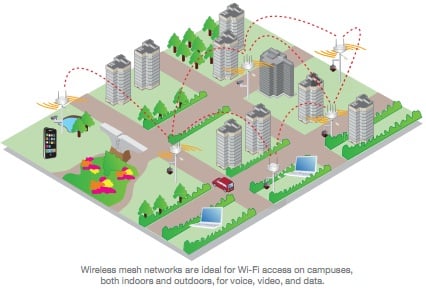It's not a secret anymore, mobile is everywhere and it's transformed how the world operates, especially in education. From BYOD and 1:1 programs to interactive and personalized learning our schools have been evolving at a rapid pace to support their students needs and demands in this new environment. However, staying ahead is challenging for even the most seasoned IT professionals and just when you thought you had a handle on things, new technology comes out set to change things once again. Beacons and location based solutions are here, but what are they and how will they be used in education?
What's a Beacon?
Beacons are devices that enable context-aware mobile engagement by transmitting signals to smartphones or similar devices based on location and other variables such as time of day and application. Then through the use of an application, content is pushed to your user based on those variables mentioned above.
At it's most basic beacons pair with an app that runs on your users device that then will deliver location-based messaging or content customized by your school.
Some of the common names associated with beacons out there today are iBeacon (Apple), BLE or Bluetooth Low Energy and Bluetooth Smart.
Why Education?
The retail world has led the way with utilizing beacon technology to engage their customers while shopping inside of their stores, but why would this be applicable in education? It's all about the experience and context. Using technology in the classroom has been a natural development to our students growing demands and needs but has also caused a disconnect between students and their physical world. Beacons offer a solution that can add that contextual experience and real-world interaction back into our students everyday classroom experience.
The power of beacons comes from the beacon itself but even more so from the application its paired with. There are almost no limits to what can be done, to give you a bigger picture of what is possible here are 11 helpful ways beacons are changing education.
1) Wayfinding
With beacons students can now navigate your school or campus easier than ever before. Paired with an app you can offer things like guided tours and interactive maps. It's a simple concept but offers students the ability to experience your school in a new and interesting way as well as making their lives a lot easier.
2) Location Based Messaging
In addition to wayfinding, you can also provide your users with coupons, discounts and other offers to specific locations around your campus such as book stores, restaurants and coffee houses.
3) Security Badges
A lot of campuses and schools there are many buildings that require costly security infrastructure to safeguard access to certain areas. Now using beacons school IT leaders can get rid of badge readers outside of buildings, allowing students and staff to access certain buildings through an application on their individual devices.
4) Learning Zones
Being contextually-aware beacons allow schools to set-up learning zones within each classroom, offering customized content to their students when they are in these specific areas of the classroom.
5) Attendance
Beacons make it possible for schools to automatically take attendance and allow students to automatically check in at events.
6) Triggering Notifications
In places like book-stores you can trigger contextual marketing messages for things like sales, special offers and even wait-times in line.
7) Extending the Classroom
Take the classroom to new places and use beacons to interact with different landmarks and other physical objects turning everything and anything into a learning experience.
8) Classroom Material
Beacons offer enhanced communication between students and faculty, for example teachers can give their students specific classroom materials such as notes, deadlines, and assignment schedules.
9) MDM
Pairing beacons with an MDM solution gives schools the ability to restrict access simply based on when the teacher enters the classroom. This could trigger an action that changes the level of access students have on their devices.
10) Emergency Aware
In the event of an emergency beacons can allow teachers and other school administrators to know exactly where each student is located. This is an obvious advantage to having beacon technology and location based solutions, when it comes to student safety having the ability to keep an accurate account of each student is critical.
11) Location Analytics
Beacons combined with applications allow schools to monitor traffic patterns of their students and faculty. By using this data schools can create a more efficient campus experience, eliminating bottlenecks, improving scheduling and leading to overall better campus design.
Although still relatively new beacon technology has the potential to take education to a completely new level. By providing contextually aware content your students and staff can have a truly connected experience while using mobile. There's really no limit to what can be done when pairing beacons with different applications, the question shouldn't be what can beacons do but what can't they do.




![What’s the Difference Between 802.11ac Wave 1 and Wave 2? [FAQ’s]](https://techgrid.com/hubfs/whats-the-difference-between-802.11ac-Wave-1-and-Wave-2-FAQs.jpg)

